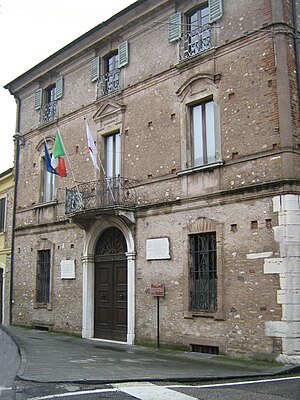International Museum of the Red Cross
 The entrance of the International Museum of the Red Cross |
|
| Data | |
|---|---|
| place | Castiglione delle Stiviere |
| Art |
history
|
| opening | 1959 |
| operator | |
| Website | |
The International Museum of the Red Cross , in Italian Museo Internazionale della Croce Rossa , is a museum that has existed since 1959 in the town of Castiglione delle Stiviere in the Italian province of Mantua . It is dedicated to the historical documentation of the origin and development of the International Red Cross and Red Crescent Movement .
History of origin
The special reference of the city of Castiglione delle Stiviere to the history of the Red Cross results from the events after the Battle of Solferino , which took place on June 24, 1859 just a few kilometers from the city. In the days following the battle, the activities of Henry Dunant made the town the center of aid to the wounded. Dunant published his experiences in Solferino and Castiglione delle Stiviere in 1862 in a book entitled "A Memory of Solferino".
“… The women from Castiglione followed my example when they saw that I made no distinction between nationalities and showed the same kindness to all men of different origins, even to those who were completely foreign to them. “All brothers” they repeated out of pity. Honor the kind women and girls from Castiglione ... "
This book gave rise to the founding of the International Committee of the Red Cross (ICRC).
The museum was created on the initiative of Enzo Boletti , a citizen of Castiglione delle Stiviere. During the Second World War, Boletti was taken prisoner by the Soviets on September 8, 1943. In 1950, his family received news of his fate for the first time, and thus a sign of life from him, through the Central Information Center for Prisoners of War of the International Committee of the Red Cross. Four years later, on November 25, 1954, he returned to Italy. This made him the last Italian citizen to be released from captivity in another country after the Second World War. In the years following his return, he became mayor of his hometown. Out of personal gratitude to the International Committee of the Red Cross, he and his family campaigned for the establishment of a museum to document the history of the Red Cross at a historic site in Castiglione delle Stiviere. Enzo Boletti is therefore now considered to be the founder of the museum and was its first president.
The museum is located in Castiglione delle Stiviere in Palazzo Longhi, the former palace of the noble Triulzi-Longhi family from the 18th century. It opened on June 25, 1959. The facility was largely financed by private donations as well as a large donation from an Italian bank to the Italian Red Cross Society. The Italian Red Cross is the sponsor of the museum.
exhibition
The design and furnishing of the exhibition is primarily geared towards a historical perspective. The museum shows, among other things, some drawings from 1859 as well as objects that were used in the days after the battle. In addition, the exhibition contains medical equipment and vehicles for ambulance transport from different eras as well as a collection of stamps with the theme “The Red Cross Worldwide”. One of the first rooms has copies of the five Nobel Prize certificates awarded to Henry Dunant (1901), the International Committee of the Red Cross (1917, 1944, 1963) and the League of Red Cross Societies (1963). Different areas of the museum are devoted to some specific aspects of the activities of the International Red Cross and Red Crescent Movement, such as anti- landmines and the importance of the Geneva Conventions .
other activities
The museum has been organizing an annual international tented camp since 1992 under the name "Da Solferino a Castiglione Fiaccolata". Since 1997, part of the event has been a team competition for the Trofeo Massimo Ghio , named after an Italian Red Cross delegate who was active in Albania and Rwanda, among others. The competition consists of sporting and playful activities, knowledge tests on the history of the Red Cross and international humanitarian law as well as practical tests in first aid. The highlight of the camp is a torchlight procession from Solferino to Castiglione on June 25th, in which several thousand people have taken part in the last few years, mostly active Red Cross members from different countries. The procession follows the path that took the injured to Castiglione after the Battle of Solferino.
Web links
- Museo Internazionale della Croce Rossa Website of the museum (Italian, some information in Spanish, German, English, French)
Coordinates: 45 ° 23 ′ 21.2 " N , 10 ° 29 ′ 32.4" E